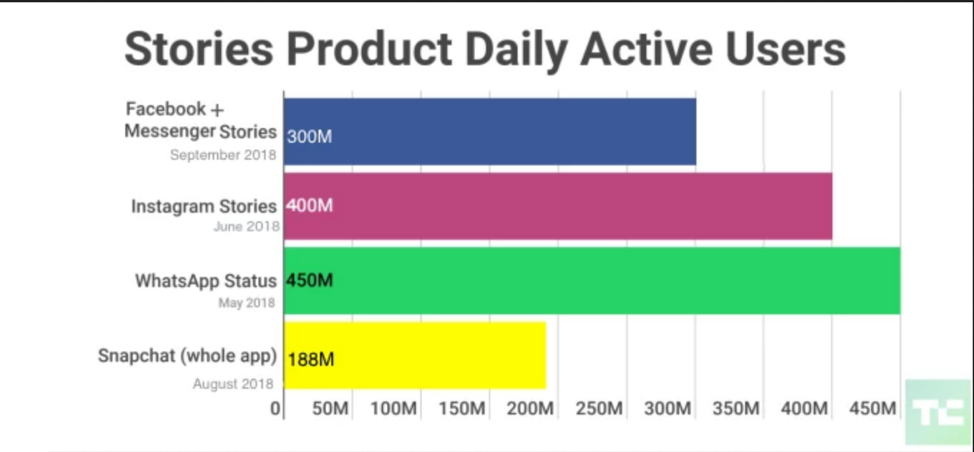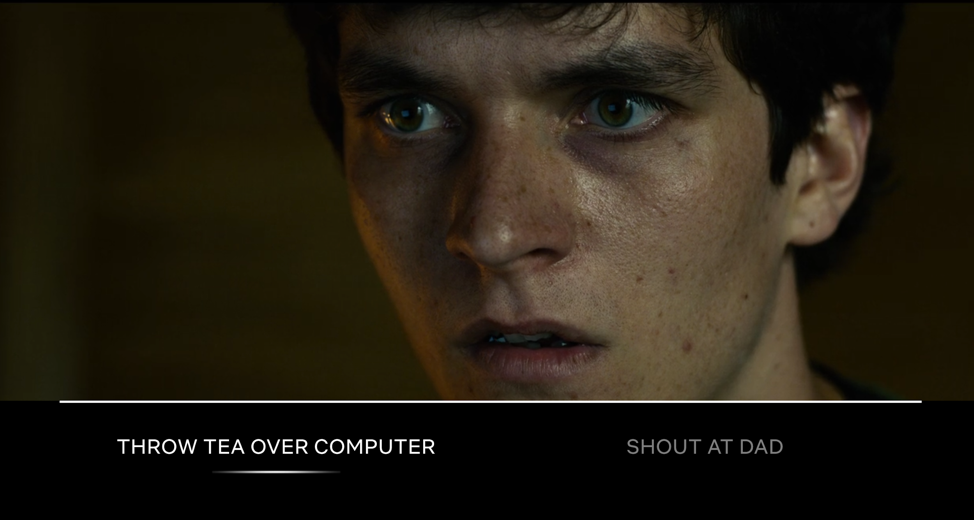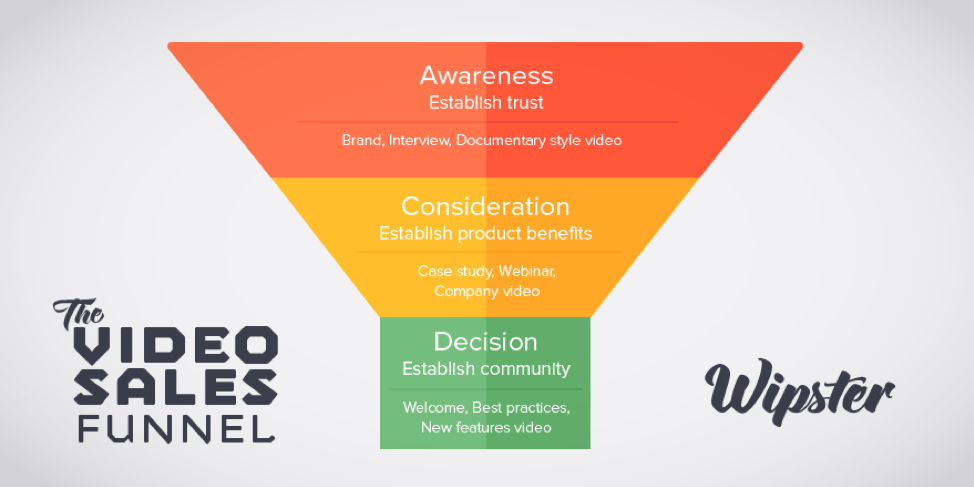As of 2018, 87 percent of businesses are using video marketing tools, according to the latest research. But how many are doing it well? And how many are just following the herd?
In a packed field it’s tough for brands to stand out against the noise. So we’re looking ahead to what’s next in video marketing. Here are five of the biggest opportunities for brands who plan to stay ahead of the crowd.
-
Stories
On social media, Stories will surpass the newsfeed as the top way to share in 2019, according to Facebook’s Chief Product Officer, Chris Cox. Use of Stories has grown at 15 times the speed of regular newsfeeds over the past years. And across platforms, there are over a billion users.

(Source: TechCrunch)
What are they?
Stories are a disappearing slideshow format. They feature vertical, mobile-first video—but also text, images, camera lenses, drawings, you name it. Snapchat invented the format, but Instagram introduced its own version in 2017. It’s since been embraced by Facebook, Messenger, WhatsApp and even YouTube.
Why are they trending?
Stories are compelling because they’re real, immediate and spontaneous. They’re less polished than other types of video, and because most of them disappear there’s plenty of room for experimentation and even playfulness.
Stories are also mobile-first: they’re made and consumed without ever passing through a desktop interface. Currently, 34 percent of people watch video mainly on mobile, while only 17 percent watch video from their desktop.
Popularity among users means advertisers are also flocking: as of January 2019, Facebook says 2 million advertisers are buying Stories ads. And a Hootsuite poll found 64 percent of marketers were integrating Stories into their social strategy in the next year, if they hadn’t already.
Pro tips
-
Take the wide view: Just as with newsfeed, brands who are strategizing for Stories are at the mercy of social media platform algorithms, now and in the future. Remember that it’s the immediacy and transparency of Stories that have people hooked. That emotion can be harnessed and transferred through all your video channels, not just the ones controlled by Facebook.
-
Quality over quantification: Also keep in mind that measuring ROI and engagement on Stories is still difficult, given the lack of a robust API. Stories are a great addition to your sales strategy, but they aren’t ready to be the prime channel.
-
Interactive Video
In 2018, only 23 percent of video marketers tried interactive video as a tool, yet 83 percent of them reported it was successful.
Simultaneously, ninety percent of video marketers feel that competition and noise has increased in the last year. Ads in general are becoming more expensive and less effective as people grow adept at filtering them out. Only the most engaging video is making an impression, which is where interactive video comes in.
What is it?
Interactive video is highly versatile. It can be anything from Netflix’s elaborate choose-your-own-adventure Black Mirror special, to 360-view video, to adding topic chapters to an explainer video to make it easier to navigate.

(Source: Bandersnatch, Black Mirror)

(Source: YouTube Creators)
A familiar example of interactive video is YouTube cards and endscreens. These are pop-ups that might encourage viewers to follow a channel or vote in a poll. Anything that asks a viewer to choose and take action while watching the video—in other words, to state their preference and in the process hand over data—qualifies as an interactive video.
Why is it trending?
Interactivity allows viewers to prioritize what matters to them. They can choose the content they want, skip what’s not useful or interesting, and take action directly from the video.
People like it so much that they’ll spend 47 percent more time with an interactive video, and they also report that interactive videos are 32 percent more memorable, driving 9 times as much purchase intent.
Marketers love interactive video because by nature it offers more advanced analytics. Any action (or non-action) that a viewer takes translates directly into valuable data. Rather than tracking general numbers like views or average watch time, interactive video analytics can be linked directly to ROI. Marketers can see which sections got skipped, which were rewatched, what got clicked, and how long viewers stayed to watch.
Pro tips
-
Gamify the experience: Interactivity should enhance the user experience, not just float irrelevantly on top of the video (remember YouTube annotations?). Whether you build out branching, unique experiences for your viewers to navigate, or give them valuable information about a product they can click to buy, the goal of gamification is to surprise and delight.
-
Walk don’t run: While Netflix had to build a custom project management system and shoot 5 hours of footage for their 90-minute Black Mirror episode, interactive video can be much simpler. For instance, adding clickable calls-to-action on your brand’s existing videos is as easy as adding a tagg.
3. Video Sales Funnels
Viral video is dead—or at least it’s dead to marketers who want to strategize using data, rather than take shots in the dark. While you’ll still find “viral-style videos” as line items in some marketing budgets, fewer and fewer marketers are counting on metaphorical lightning strikes to achieve their ROI.
Instead, a scalable and sustainable approach to video marketing is necessary. Enter the video sales funnel.

(Source: Wipster)
What is it?
You’re probably already familiar with the standard sales funnel. The idea is to meet your fans and potential customers wherever they are: looking for solutions? annoyed at a competitor? comparing prices or features? justifying their gut instinct with data?
Video amplifies your brand’s messaging throughout this journey. 68 percent of consumers say they want brands to give them content in the form of video over any other type of content. The idea is to create a diverse, multi-channel web that catches your target audience and meets them with their preferred content: engaging, informative and entertaining.
Why is it trending?
No one wants to see annoying or boring ads. The idea of investing time and money into one top-of-funnel awareness video leaves marketers competing with every other distraction out there. By giving people the right information at the right time, and using remarketing to keep them interested, a video sales funnel creates a holistic net of valuable content.
Pro Tips:
-
Don’t reinvent the wheel: Give your audience more of what they’ve already told you they want. Script and film your most popular blog post. Film a demonstration to show your product in action. Livestream a Q&A or hold a webinar. Encourage video testimonials from customers, or get your founder to film a thank you that can be personalized.
-
Go modular: Film all of your videos at once, whether you’re doing a fifty-piece cross-channel campaign, or a smaller series. This will make for a consistent feel for all of your messaging and is more efficient and less expensive to produce. It also allows for components to be mix-and-matched as you test and trouble-shoot down the line, replacing low-performing videos or rolling out a series on a timeline.
4. One-to-One Video
One thing is for sure: there aren’t enough hours in the day. That goes for you and your customers both. Make sure your marketing is a service that makes your customer’s life—or job—easier, not another annoyance they need to avoid or ignore.
Personalized video marketing is a key challenge for 50 percent of marketers. Integrating one-to-one video into your marketing strategy is a way to build trust and speed your customer’s journey down the sales funnel, and it’s as simple as using a video-optimized CRM.
What is it?
One-to-one videos are customized outreach videos that seamlessly weave in details like company name, specific needs or pain points, and personal messages. They can be shot on the fly without anything fancier than a smartphone (and flattering lighting, of course.)
Also known as visual voicemail, one-to-one videos are best known for replacing cold calls—which have the risk of hitting your target at an inconvenient moment, or else going to their voicemail trash bin. However, with the right preparation, these videos can also easily replace emails, slideshows or white papers.
These videos are the pointy end of the personalization trend, and are especially effective in B2B sales. Use them to introduce your team, provide a data-driven pitch, effectively demo a product, and follow up on inquiries with information to nudge leads in the right direction.
Why is it trending?
According to Edelman’s Trust Barometer for 2018, 60 percent of people no longer trust social media platforms, and consumers are increasingly skeptical of common data marketing techniques that don’t prioritize their privacy.
This means that intimate, meaningful conversations with smaller audiences are necessary for brands to build trust with their audience. Think: fewer celebrity influencers, more experts and peers. Less reach, more authenticity.
Lending a human face to your outreach with one-to-one video shows people your brand is human, too.

(source: Edelman 2018 Trust Barometer)
Pro tips
-
Be proactive: No one can predict the perfect time to reach out, but be transparent and communicate frequently as you build relationships.
-
Make your call to action easy: with the right tools, (we’re biased, but we like TaggCRM) you can encourage people to call or email you from within the video, or visit your website to learn more.
-verb
